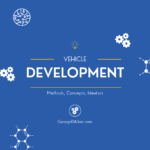Craft User Interfaces: New System Content for Advanced Tech

Craft User Interfaces - New System Content for Advanced Tech:
Introduction – User Interfaces
The contemporary complexity of vehicle content calls for governing logic to manage inputs and outputs related to data acquisition and resultant analysis execution. Therefore, this article delves into the recipients (Users and User Interfaces) of the signals generated by this logic and computations.
Consequently, the Systems Engineering method defines the interfaces between the executive systems within vehicle features and designates the responsible parties as Users. Moreover, a well-designed user interface (UI) ensures seamless interaction, enhancing both functionality and reliability of the intended function.
In conclusion, optimizing User Interfaces is paramount for ensuring the effective operation of complex vehicle systems. Thus, this exploration of User Interfaces highlights their importance in modern vehicle systems engineering.
Governing Feature User Interfaces Map
Generally, the governing feature is described by the Functions Map, which includes a series of graphs and documents. Furthermore, it shows the relationship between the executive systems. This is followed by a specific demonstration of the connectivity between the subsystem generating the resultant signals and the subsystems receiving them. Moreover, the recipients (Users) would have to incorporate the incoming signals into their logic to execute the feature functional requirements.
In addition, this entails the following:
- The library of common signals and their definitions
- The capabilities related to accepting and processing the incoming sets of signals
- The developed necessary logic to satisfy the high-level requirements for the proper execution of the intended function
Furthermore, understanding the Functions Map is crucial for optimizing User Interfaces in vehicle systems. By comprehending the relationships and connectivity outlined in the Functions Map, the responsible parties can enhance the efficiency and functionality of their interactions within vehicle systems for the development of the intended functionality.
Consequently, a well-defined Functions Map is essential for ensuring seamless communication between various subsystems. Thus, the Governing Feature User Interfaces Map plays a vital role in modern vehicle systems engineering.
Definition of the User Interfaces and Data Sets
Overall, there are two major types of Users: Internal and External.
Firstly, the Internal Users are the ECUs (Electronic Control Units) employing the necessary logic for execution of the feature function. Consequently, within the Passive Safety Features, the signals generated by the Occupant Sensing System interface with various internal users, such as the Crash Management System and the Seat Belt Monitoring System among others. Therefore, these represent the Internal Users, and covered in the System Requirements – both Functional and Interface requirements sections.
Secondly, the External Users are entities that are not part of the vehicle content but require the information generated by the provider. Hence, the necessary information is specified in the Interface Requirements section of the system documentation. Moreover, it includes:
- Naming each External User and the purpose of the information set provided
- Specifying the documentation or information set containing the signal or information output
- Speed with which this information is necessary – instantaneous for some, released documents for others
- Other possible specifics
Examples of External Users include:
- Service and Maintenance departments needing guidance with Maintenance and Service Manuals
- Vehicle Assembly lines requiring post-assembly verification activities
- Vehicle communication interfaces, such as OnStar, other emergency services, and specifically designated users
Furthermore, each User Interface needs to be developed concerning the specificity of the information data set for the given user. Therefore, this ensures that both Internal and External Users receive the proper information on time, enhancing the overall functionality and reliability of vehicle systems. Moreover, understanding and defining User Interfaces and data sets are crucial for optimizing vehicle performance.
Interface Control Documents – Establish Communication Protocol
A key derivative of the developed System’s requirements is the Interface Control Document (ICD) between the provider and the recipient of the information sets. Moreover, the ICD must be very specific regarding signal names, their definitions, and the intent of their inclusion in the executing algorithm. Furthermore, the content and intent of the information sets provided to the user govern the communication protocol between the subsystems (ECUs).
Consequently, the ICD is developed at the subsystem level and mirrors the system’s intent with a set of quantifiable specific requirements, which are not available in the systems documentation. Additionally, the subsystem documentation is used by OEM purchasing teams to source off-the-shelf technologies. Therefore, it is crucial for the OEM to have comprehensive information about the interface and intended communication.
Moreover, establishing clear and detailed ICDs ensures that user interfaces function properly. Therefore, this enhances the overall reliability and performance of vehicle systems. Consequently, a well-structured ICD is vital for optimizing user interfaces and ensuring seamless integration of various vehicle components. Thus, understanding and implementing effective communication protocols through ICDs is essential for modern vehicle systems engineering.
Development of the Corporate Strategy related to the New Vehicle Content - Addressing Corporate Politics
Generally, addressing corporate politics related to sourcing activities is essential. Firstly, it is imperative to comprehend the availability of “off the shelf” technology for the intended vehicle content when sourcing the supply base by Purchasing. Therefore, preliminary development work and readiness assessment are paramount tasks, clearly lying between the Advanced Engineering Team and Vehicle Program Management.
Furthermore, it is highly advisable to develop functional simulation capabilities to demonstrate verifiable functional and User Interface readiness. Moreover, these capabilities ensure that the new vehicle content meets the necessary requirements and operates seamlessly. By focusing on these aspects, the corporate strategy can effectively navigate internal politics, ensuring that all stakeholders are aligned and that the project progresses smoothly.
Consequently, demonstrating User Interface readiness through simulations helps in building confidence among decision-makers and mitigates potential conflicts. Therefore, a well-developed corporate strategy that includes thorough assessments and simulations not only addresses corporate politics but also ensures the successful integration of new vehicle content. Thus, understanding and strategically managing these elements are crucial for the advancement and success of vehicle systems engineering projects.
Conclusion: Users and User Interfaces
In conclusion, it is crucial to comprehend all of the Users and specificity of each User Interface.
Consequently, the governing feature and system’s intent are described in the respective documents (Feature and System Requirements – FTS and STS), illustrating the proper intended signal flow. Furthermore, quantifiable requirements are listed in the subsystem-level documentation for each participant of the vehicle content and covered in the interface requirements (SSTS). Moreover, the interfaces and intended protocols should be detailed in the Interface Control Documents for each recipient (User) of the information generated and available.
In addition, comprehending the necessary requirements is essential for the smooth implementation of new technology or intended functions. Hence, the success of vehicle development and launch projects depends on knowing “what to do” rather than learning on the fly or facing emergencies related to missed failure modes. A well-documented and clearly defined User Interface ensures that all systems operate seamlessly and efficiently. Therefore, paying close attention to User Interfaces and their requirements is paramount in modern vehicle systems engineering.
References
https://georgedallen.com/develop-new-system-content-proposal-craft-advanced-tech/
https://georgedallen.com/new-systems-engineering-as-applied-philosophy-of-objectivism/
https://en.wikipedia.org/wiki/Engineering_ethics
https://georgedallen.com/upholding-objectivist-principles-navigating-basic-engineering-ethics/
https://georgedallen.com/new-engineering-ethics-fundamentals-of-product-development/
About George D. Allen Consulting:
George D. Allen Consulting is a pioneering force in driving engineering excellence and innovation within the automotive industry. Led by George D. Allen, a seasoned engineering specialist with an illustrious background in occupant safety and systems development, the company is committed to revolutionizing engineering practices for businesses on the cusp of automotive technology. With a proven track record, tailored solutions, and an unwavering commitment to staying ahead of industry trends, George D. Allen Consulting partners with organizations to create a safer, smarter, and more innovative future. For more information, visit www.GeorgeDAllen.com.
Contact:
Website: www.GeorgeDAllen.com
Email: inquiry@GeorgeDAllen.com
Phone: 248-509-4188
Unlock your engineering potential today. Connect with us for a consultation.


